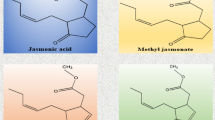Summary
Various octadecanoids and derived compounds have been identified in potato leaves. However, information regarding jasmonate hydroxylated forms in stolons or tubers is scarce. We investigated endogenous jasmonates in stolon material ofSolarium tuberosum cv. Spunta. Stolons and incipient tubers were collected from 8 weeks old plants. The material was cut into apical regions and stolons. We identified jasmonic acid (JA), methyl jasmonate, 11-OH-JA, 12-OH-JA, 12-oxo-phytodienoic acid (OPDA) and a conjugate. The content of JA and 12OH-JA decreased in the apical region but remained high in stolons during tuberization. Thus the apical region might be a site of JAs-utilization or metabolization and stolons might supply JAs to that region. The content of 12-OH-JA was higher than that of 11-OH-JA in all stages analyzed, both in apical regions and stolons. However, these compounds showed a different time-course in the apical region: while 11-OH-JA increased, 12-OH-JA decreased. Thus, JA from leaves or roots could be transported as 12-OH-JA to the apical region, stimulating tuber formation.
Similar content being viewed by others
References
Abdala, G., G. Castro, O. Miersch & D. Pearce, 2002. Changes in jasmonates and gibberellins during development of potato plant (Solanum tuberosum L.).Plant Growth Regulation 36 (2): 121–126.
Abdala, G., O. Miersch, R. Kramell, A. Vigliocco, E. Agostini, G. Forchetti & S. Alemano, 2003. Jasmonate and octadecanoid occurrence in tomato hairy roots. Endogenous level changes in response to NaCl.Plant Growth Regulation 40(1): 21–27.
Boland, W., J. Hopke, J. Donath, J. Nüske & F. Bublitz, 1995. Jasmonic acid and coronatin induce odor production in plants.Angewandte Chemie Internationale Edition England 34: 1600–1602.
Castro, G., T. Kraus & G. Abdala, 1999. Endogenous jasmonic acid and radial cell expansion in buds of potato tubers.Journal of Plant Physiology 155: 706–710.
Castro, G., G. Abdala, C. Agüero & R. Tizio, 2000. Interaction between jasmonic and gibberellic acids on in vitro tuberization of potato plantlets.Potato Research 43: 83–88.
Cenzano, A., A. Vigliocco, T. Kraus & G. Abdala, 2003. Exogenously applied jasmonic acid induces changes on the apical meristem morphology of potato stolons.Annals of Botany 91(7): 917–921.
Creelman, R.A. & J.E. Mullet, 1997. Biosynthesis and actions of jasmonates in plants.Annual Review of Plant Physiology and Plant Molecular Biology 48: 355–381.
Cui, B., M. Nakamura, J. Kinjo & T. Nohara, 1993. Chemical constituents of astragali semen.Chemical Pharmaceutical Bulletin 41: 178–182.
Gidda, S.K., O. Miersch, A. Levitin, J. Schmidt, C. Wasternack & L. Varin, 2003. Biochemical and molecular characterization of a hydroxyjasmonate sulfotransferase fromArabidopsis thaliana.Journal of Biological Chemistry 278: 17895–17900.
Hause, B., I. Stenzel, O. Miersch, H. Maucher, R. Kramell, J. Ziegler & C. Wasternack, 2000. Tissue-specific oxylipin signature of tomato flowers: aliene oxide cyclase is highly expressed in distinct flower organs and vascular bundles.The Plant Journal 24: 113–126.
Helder, H., O. Miersch, D. Vreugdenhil & G. Sembdner, 1993. Ocurrence of hydroxylated jasmonic acids in leaflets ofSolanum demissum plants grown under longand short-days conditions.Physiologia Plantarum 88: 647–653.
Jackson, S.D., 1999. Multiple signaling pathways control tuber induction in potato.Plant Physiology 119: 1–8.
Kiyota, H., D. Nakashima & T. Oritani, 1999. Synthesis of ( )-methyl tuberonate, a potato tuber-forming substance, and its epimer.Bioscience Biotechnology Biochemistry 63: 2110–2117.
Koda, Y., E. Omer, T. Yoshihara, H. Shibata, S. Sakamura & Y. Okazawa, 1988. Isolation of a specific tuber-inducing substance from potato leaves.Plant Cell Physiology 29: 1947–1051.
Koda, Y., 1997. Possible involvement of jasmonates in various morphogenic events.Physiologia Plantarum 100: 639–646.
Kolomiets, M.V., DJ. Hannapel, H. Chen, M. Tymeson & R.J. Gladon, 2001. Lipoxygenase is involved in the control of potato tuber development.Plant Cell 13: 613–626.
Matsura. H., T. Yoshihara, A. Ichihara, Y. Kikuta & Y. Koda, 1993. Tuber-forming substances in Jerusalem artichoke (Helianthus tuberosus L.).Bioscience Biotechnology Biochemistry 57: 1253–1256.
Miersch, O., G. Schneider & G. Sembdner, 1991. Hydroxylated jasmonic acid and related compounds fromBotryodiplodia theobromae.Phytochemistry 30: 4049–4051.
Mueller, M.J., 1997. Enzymes involved in jasmonic acid biosynthesis.Physiologia Plantarum 100:653–663.
Sembdner, G., A. Meyer, O. Miersch & C. Bruckner, 1990. Metabolism of jasmonic acid. In: R.P. Pharis & S.B. Rood (Ed.), Plant Growth Subtances. Springer-Verlag, New York, pp. 374–379.
Sembdner, G. & B. Parthier, 1993. The biochemistry and the physiological and molecular actions of jasmonates.Annual Review of Plant Physiology and Plant Molecular Biology 44: 569–589.
Simko, I., E.A. Omer, E.E. Ewing, S. Mcmurry, J.L. Koch & P.J. Davies, 1996. Tuberonic (12-OH-JA) acid glucoside and its methyl ester in potato.Phytochemistry 43: 727–730.
Ueda, M. & S. Yamamura, 1999. Potassium ß-D-glucopyranosyl 11-hydroxyjasmonate, a leaf-closing substance ofAlbizzia julibrissin Durazz.Tetrahedron Letters 40: 7823–7826.
Wasternack, C. & B. Hause, 2002. Jasmonates and octadecanoids signals in plant stress response and development. In: K. Moldave (Ed.), Progress in Nucleic Acid Research and Molecular Biology. Academic Press New York 72, pp. 165–221.
Yoshihara, T., E. Omer, H. Koshino, S. Sakamura, Y. Kikuta & Y. Koda, 1989. Structure of a tuber-inducing stimulus from potato leaves (Solanum tuberosum L.).Agricultural and Biological Chemistry 53: 2835–2837.
Yoshihara, T., H. Matsura, A. Ichihara, K. Kikuta & K. Koda, 1992. Tuber forming substances of Jerusalem artichoke (Helianthus tuberosus L.). In: C.M. Karssen, L.C. van Loon & D. Vreugdenhil (Ed.), Progress in Plant Growth Regulation. Kluwer Academic Publishers, Dordrecht, pp. 286–290.
Yoshihara, T., M. Amanuma, T. Tsutsumi, Y. Okumura, H. Matsuura & A. Ichihara, 1996. Metabolism and transport of [2-14C] (±) jasmonic acid in the potato plant.Plant Cell Physiology 37: 586–590.
Author information
Authors and Affiliations
Corresponding author
Rights and permissions
About this article
Cite this article
Cenzano, A., Vigliocc, A., Miersch, O. et al. Hydroxylated jasmonate levels during stolon to tuber transition inSolarium tuberosum L. Potato Res. 48, 107–115 (2005). https://doi.org/10.1007/BF02742370
Accepted:
Issue Date:
DOI: https://doi.org/10.1007/BF02742370




